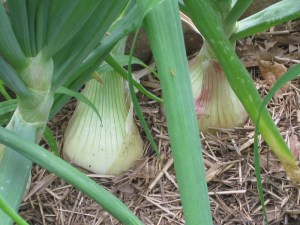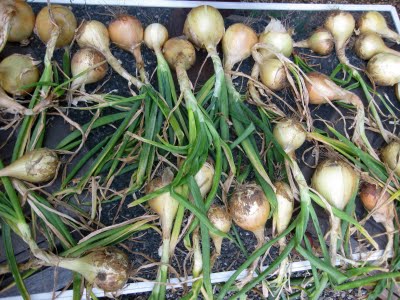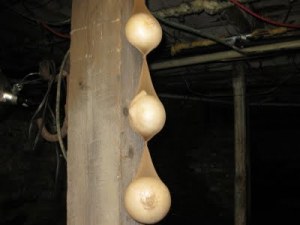Last updated on February 13th, 2012
 BECAUSE MY SUMMER VEGGIE GARDEN has to feed me during winter, I’m careful to harvest and store whatever I grow. I’ve already “put up” green beans and kale. Next up? About 300 onions. To keep the bulbs fresh all winter and beyond, they must first be cured in the sun. Next, they must be stored in a manner that does not invite rot. The following program works for me:
BECAUSE MY SUMMER VEGGIE GARDEN has to feed me during winter, I’m careful to harvest and store whatever I grow. I’ve already “put up” green beans and kale. Next up? About 300 onions. To keep the bulbs fresh all winter and beyond, they must first be cured in the sun. Next, they must be stored in a manner that does not invite rot. The following program works for me:
Onions are ready for harvest when their green tops fall over. After lifting the bulbs, brush or shake off loose soil. Then lay them out in a single layer in the sun, on some type of surface that will permit ventilation from below. I spread mine out on window screens, balanced between chairs, blocks or raised beds in the kitchen garden. The bulbs are permitted to “cure” in sun and air for 2-3 weeks, or until their outer skins turn papery, and their green stalks wither and brown. Curing is vital to winter-storage success.
 Here, freshly-harvested onions “cure” on an old window screen
Here, freshly-harvested onions “cure” on an old window screen
It is imperative that bulbs remain dry throughout the curing period. At the first threat of rain, either move the onions to a sheltered location until fair skies return, or cover the bunch with burlap.
After curing, cut off all but one inch of stem. Then store the bulbs in a dim, dry, cool place, such as a cellar or unheated attic. Some gardeners like to pile their onions in a woven basket for the cool duration, but I have found this arrangement leads to rot. A better plan is to secure the onions in such a way that they receive maximum ventilation. And this plan involves — you guessed it — pantyhose.

Cut the “panty” from the panty hose. Then place within a detatched leg one onion, and above it, tie a knot. Continue this knotting and onioning until the stocking is sufficiently filled.
The bulbs, secure in their lingerie-quarters, can be suspended from either a hook or a rafter. To facilitate hanging, I like to insert a length of 22-gauge wire through the top knot. And when an onion is required, I simply cut or tear an opening in the stocking, and retrieve a single bulb.
Why miss anything at A Garden for the House? Sign up for Kevin’s weekly newsletter!
Related Posts:
Recipe: Butternut Squash Soup with Sherry & Thyme
Super-Fast Fall Crops
The Easy, Easy Kitchen Garden
How to Harvest & Store Winter Squash
A Garden for the House Home Page

Justin says
Kevin, you make harvesting, curing and storing onions sound like fun! Should I follow the same treatment for onions bought at the Farmer's Market?
Katreader says
What perfect timing. I got walla walla onions from a wine and herb fest and was wondering how to know when to harvest. Thanks so much.
Kevin Lee Jacobs says
Justin – yes, providing they are “storage” onions, not sweet varieties.
Katreader – sounds like we are enjoying the same gardening activities! Are you in the same hardiness zone as me — 5b?
Eric says
I didn't let my onions cure properly last year. I just laid them on a bench in my garage, and they turned to mush before winter arrived. I'll try your method this time. My onions – don't recall the variety, but they are supposedly “keeping” kinds — are huge, and ready for harvesting.
Karen says
Are the onions in the picture hanging in your basement?
Kevin Lee Jacobs says
Eric – I've made that same mistake in the past, too. The curing process is crucial for storage-success.
Karen – Yes, although my house was built in 1826, so it is officially a “Root Cellar.” Earthen floor, and really creepy, too. Like Barnabus's cellar on the old soap opera 'Dark Shadows.'
Andrew Thompson says
Well, I hate to ask this, but what size panty hose does one buy for storing onions?
Kevin Lee Jacobs says
LOL, Andrew! In my original draft of this post, I mentioned the embarrassing prospect of we males who have to buy panty hose for garden projects. I bought “No Nonsense” 'regular' size, in a tan color. Why? Because it came 4 to a box. That means 8 stockings for onion-stuffing. I bought two boxes, and used the clerk-free “express” check out to avoid any unpleasant snickering.
Samantha says
I think white onions in black fish-net stockings would add a touch of class to any basement or root cellar!
Kevin Lee Jacobs says
I completely agree with you, Samantha! But I did not see black fish-nets at my local supermarket. I know the Pink Pussycat Boutique in Manhattan has them (or did) but I no longer live in the city. And, I could not find my Fredericks of Hollywood catalogue!
Justin says
I forgot to ask – is there a preferred temperature for onion storage?
Kevin Lee Jacobs says
Justin – preferred temps for onion storage: 40-45 degrees, give or take a few degrees in either direction.
Katreader says
Sadly, I'm not positive about my hardiness zone, but I think we're the same-or very close. I'm between Rochester and Buffalo, NY.
Kevin Lee Jacobs says
Katreader – you can find your hardiness zone here (just enter your zip code): http://www.arborday.org/treeinfo/zonelookup.cfm
(Sorry – I can't paste clickable links in the comments — I sense another upgrade coming)
Randy J says
Kevin,
Thank you for the information which I clearly had wrong last year! I got so many odd looks when I would go out in public with Onions in my pantyhose! They were awfuly convenient when I was ready to use one though!
Kevin Lee Jacobs says
Randy J – well, you've raised an interesting point, one I completely overlooked in this post:
Pantyhose, once filled with onions, ought not to be worn. Especially in public.
Andrew Thompson says
This undoubtedly explains the number of women I've seen with unsightly bulges. They have obviously stuffed onions down their pantyhose.
Katie says
I am growing onions for the first time this year and can't wait to use my old panty-hose. Great idea!
Kevin Lee Jacobs says
Katie – That's great! The lingerie-method really works!
Kimberly Marino says
i was wondering does this work on spanish onions? i got the seeds from someone and don’t know to much about them other than they said they were spanish onions
Pepper says
THANKS for all your wonderful ideas and advice! I am new to gardening and LOVE your web site!!!!!
Una says
For heaven sake, don’t go buying new pantyhose for your garden projects! Surely you have some female friends who would save you their used hosiery for garden uses. Launder and reuse! My mother taught me how to start at the top of the stocking and cut down round and round from the top, then stretch and wind this strip into a ball and you have lots of strong stretchy cord to tie up tomatoes and other plants in the garden! Beats twist ties and string every time. You can cut to wider widths for extra strength.
krystyna says
I plant onions every year,why this year I have so many going to seeds,cutting the seeds help?
Kevin Lee Jacobs says
Una – Ha! If only I had the nerve to ask a female friend for her old pantyhose! But I find it very easy to knot the hosiery between each onion. (I don’t use twist ties or string — just the hose itself.)
Krystyna – That happened to me one year when I planted onion “sets” instead of onion seedlings. Every set produced a flower stalk within weeks of planting. And once the flowering stalk emerges, that’s the end of the onion bulb’s growth. Well, live and learn. Now I only plant seedlings, which never fail to produce huge onions — without any flowering stalk to interfere with matters.
Sarah Cappelli says
Does this work with Shallots too? The green tops of my Shallots just fell over this past week and I was wondering if they were “done” and what to do with them next?
Brad says
Kevin – I learned a new trick here a few years back. There are always some small onions, some that have grown in pairs, others that have soft spots….in my case, too many to store as you have described. (Don’t get me wrong, I do that also.) But the others I put in a mini chopper and chop them up. Then I place this chopped onions in cup cake liners in my cup cake tins and freeze them. Once frozen, I take them out of the cup cake tins and put them in a freezer bag. Then, when making a soup or anything that calls for fresh chopped onion, I grab on of these “cup cakes” and use it. Very handy – and not having to deal with watery eyes and burning onion smell every time I want a fresh chopped onion.
Kevin Lee Jacobs says
Hi Sarah – So that your shallots will grow to full-size, harvest after the green stalks show brown at their tips. Then dig up the shallots and cure and store them in the exact manner described for onions. You might like to store some as Brad suggests in the comment below yours.
Hi Brad – Onion cupcakes? Excellent! Especially convenient for those who do not have a cool cellar or garage for storing whole bulbs.
naz says
THANKS for all your ideas and advice! I LOVE your web site.
Elsie says
Is this for all bulb onions? Do you have any advice on torpedo onions? I’ve been told that they can’t be stored. Thanks for all your advice, I can use all the help I can get.
Kevin Lee Jacobs says
Hi Elsie – From reports I’ve read, Torpedo onions — like all sweet onions — are highly perishable. They are not for storage. Once harvested, keep them cold in the refrigerator for a week to a month. If you’d to have onions for the long haul, do what I do, and grow ‘Copra’ or ‘Red’ onions. Both are delicious.
Barbara Wheeler says
To Brad, a question: Do you removed the onions from the panty hose before you chop them in the chopper? Yuk Yuk, just joking.
Gary Kauffman says
Kevin, I would like to know if onions will keep in old onion bags hung in a basement. I keep the bags for potatoes and other things.
Gary Kauffman says
Hi Kevin, I would like to know if using old onion bags will store as well as the stockings?
Elaine says
I’m afraid I wouldn’t be home when it rained so I’m trying to figure out “where” I could cure them for so long a time so I don’t have to worry about rain. Could a person put them on a screen and store in your garden shed with the doors open? The shed with the doors shut would be pretty hot I would guess. Do you think that would work. I have no covered porch to try either.
Kevin Lee Jacobs says
Gary Kauffman – Yes, after the onions have cured, you could store them in old onion bags.
Elaine – You are right — the next best thing to curing in the sun would be your garden shed, with doors open. Set the bulbs on a screen to insure ventilation from below.
Kelly Bryant says
What about the root? Do you cut it off after curing & when you cut tops? I was reading with beets/carrots you leave it but only leave 1/2″ of stem or root will drain veggies of moisture?
Judy says
Wonderful homemade catchup recipe want to try it real soon from tomatoes in my garden but I have a question you recipe calls for safflower oil why not olive oil ?
Glenn says
I live in a wet area and would probably not get sun for 3 full weeks. If I hung the onions in a shed with windows open would that work as well?
Mary says
Kevin, when my onion were picked, the tops (the greens) were twisted off. Does this change the drying process?
Kevin Lee Jacobs says
Hi Mary – You can cure your onions as described above as long as 1 inch or more of green stem is attached to the bulbs. If the entire stem has been removed, the neck of the onion won’t dry properly, and the onion will probably rot during storage. (Hope this answered your question!)